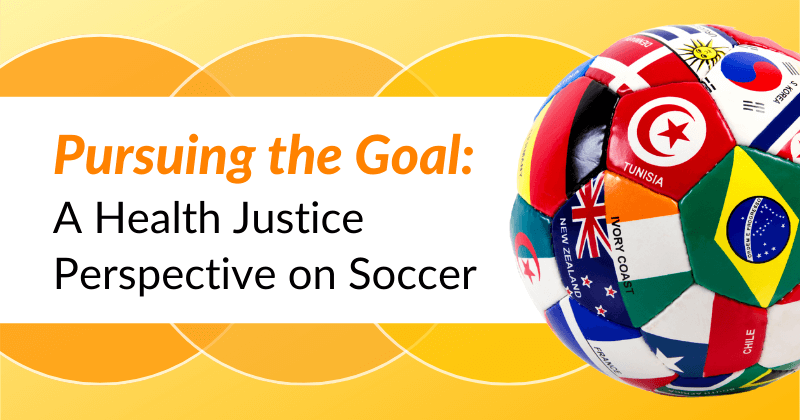Pursuing the Goal: A Health Justice Perspective on Soccer

Gooooal! The excitement of the World Cup echoes across the globe as soccer players from 32 countries compete to win the most coveted title in soccer. Taking place every four years, billions of spectators tune in to “the most-watched sporting event on Earth.”
This year’s tournament, filled with the thrill of victory and the agony of defeat, has not been without controversy. The tournament organizer, FIFA (the international association of soccer – abbreviated from the French, Fédération Internationale de Football Association), known for its of deep-seated corruption, selected Qatar to host the event despite its dismal record of human rights abuses and a climate so hot that the timing of the games was pushed from summer to winter. Qatar’s treatment of migrant workers severely tainted this year’s World Cup. These workers, largely from India, Nepal, and Bangladesh, encountered brutal conditions including forced labor, extreme heat conditions, and wage theft. Over the course of 12 years, an estimated 6,500 workers died as they built the stadiums and infrastructure to house the World Cup. The exact number of migrant worker deaths may never be known, but many of these deaths were heat-related, a cruel death that can happen immediately or slowly through diseases that destroy the body’s organs. Whether one dies from heat stroke or chronic kidney disease, heat-related deaths are completely preventable.

And soccer lovers, including myself, had to swallow this reality as we joined our fellow fans to cheer on our favorite teams. As I watch this year’s tournament, the irony of the role and treatment of immigrants is not lost on me. On one hand, I watched in dismay as FIFA with blood on its hands dismissed the outrage over worker treatment and deaths. On the other hand, I relish in the stories of the immigrant players and children of immigrants who make so many of the teams extraordinary. There’s Canada’s star player, Alphonso Davies, who was born to Liberian parents in a refugee camp in Ghana. In 2000, Milan Borjan and Milos Degenek, both ethnic Serbs fled war in Yugoslavia as refugees. Borjan went to Canada and Degenek to Australia. Both played in the World Cup for their new countries. Arguably one of the world’s greatest players, France’s Kylian Mbappé was born to an immigrant father from Cameroon. The English National Team boasts a roster with immigrant ties from Ireland to Nigeria, including their star player Harry Kane. Cody Gakpo, a top scorer from the Netherlands, was born to a Togolese father, and the tournament’s youngest player on the German team, 18-year-old Youssoufa Moukoko was born in Cameroon.
The US Men’s National Team is a talented group with roots in almost as many countries as there are players on the team. This wonderfully diverse team has a number of players with immigrant ties --- either immigrants themselves or with at least one parent who is foreign-born. Timothy Weah was born in Brooklyn to a Jamaican mother and Liberian father who is now the president of Liberia. Yunus Musah was born in the Bronx to Ghanaian parents. Jesús Ferreira, born in Colombia, became a US citizen in 2019. Sergiño Dest was born in the Netherlands to a Surinamese-American father and a Dutch mother. Cristian Roldan’s father is from Guatemala and mother from El Salvador.
I think it is safe to say that soccer needs immigrants. Even more so, American soccer needs immigrants. Yet we embrace them on the terms that best fit our narrative. German player, Mesut Ozil, son of Turkish immigrants summed up this sentiment in 2018 noting, “I am German when we win, but I am an immigrant when we lose.” In the US, we willingly allow our immigration system to perpetuate systematic abuses and racism for the millions of immigrants; they may not be soccer stars, but they do play a central role in our economy and in our country. An estimated 80 million people in the US are immigrants or children of immigrants.

As we cheered on our young squad at this year’s World Cup, I got excited thinking about what happens in the next World Cup, where the United States along with Mexico and Canada will host the tournament. And then my thoughts quickly shifted to wondering about the immigrants off the pitch -- the ones who will work tirelessly to clean our stadiums and hotel rooms, pick and process the food that we’ll eat at the games, and construct the necessary infrastructure to play the tournament. While our treatment of immigrant workers is not as dismal as in Qatar, we have much work to do. Year after year, hundreds of immigrant workers die on the job in the United States. We know that foreign-born workers are more likely to die than those who are born in the US. They work in some of the most hazardous industries and are afforded fewer protections than other workers.
In the United States, we have the opportunity and the responsibility to provide safe working conditions and ensure basic health justice for immigrant workers, from the cleaning crew to the star soccer player. Some of the basics, like protection at work and access to health care, are still dangerously out of reach for those we rely on, who fuel our economy. For example, the US still lacks federal heat standards, and only a small handful of states have heat standards in place to protect workers. As climate change progresses, these basic protections become ever more critical. Let’s not just root for our immigrants when they’re on television; let’s make meaningful progress in providing them basic safety and health, so that when they score a goal for our team, we can celebrate not just our nation, but the justice and equity that our nation stands for, and that all immigrants deserve.
Read more about MCN’s work around heat-related illnesses, including numerous resources, here. Access MCN resources on communicating safety on the job with immigrant workers here.
- Log in to post comments
